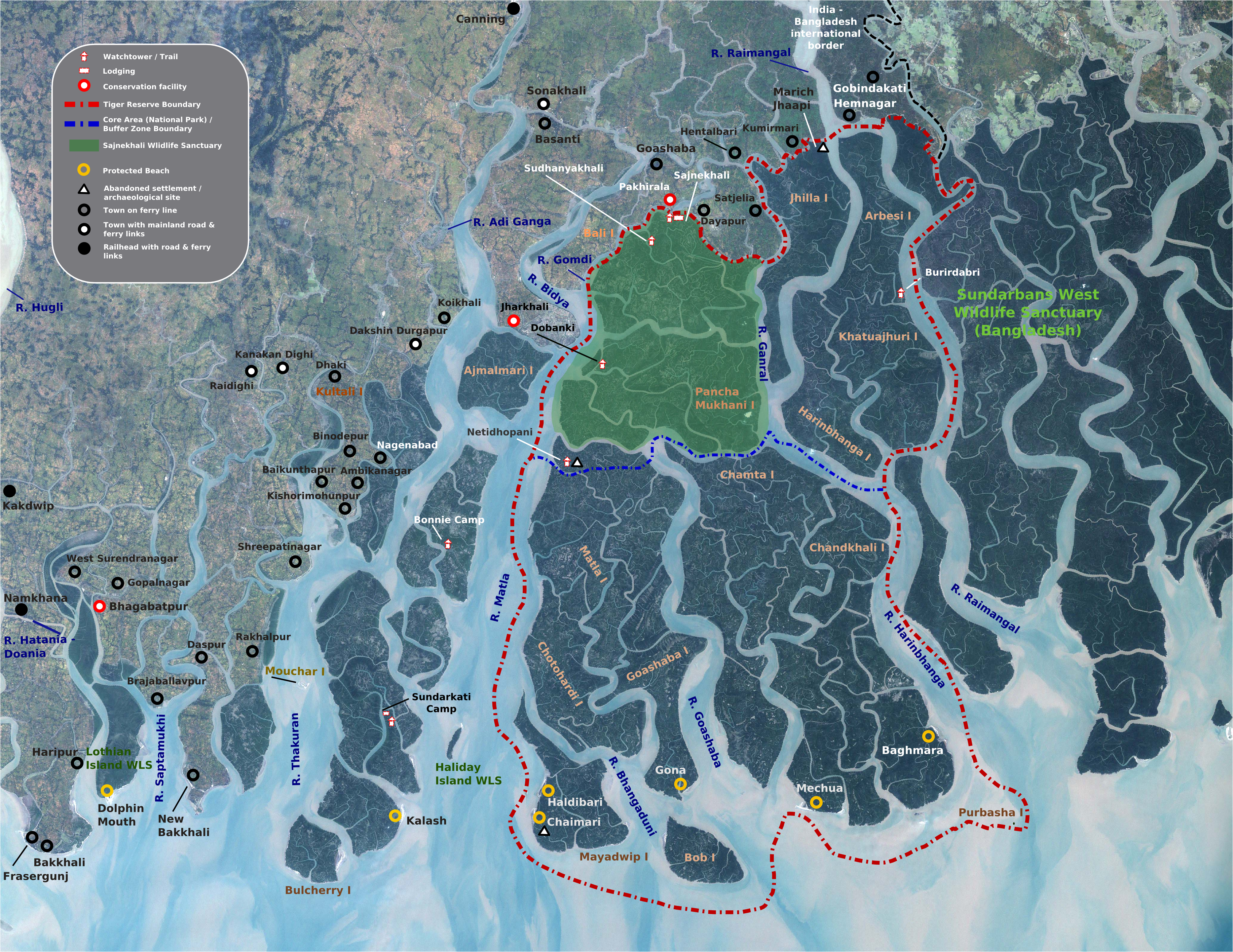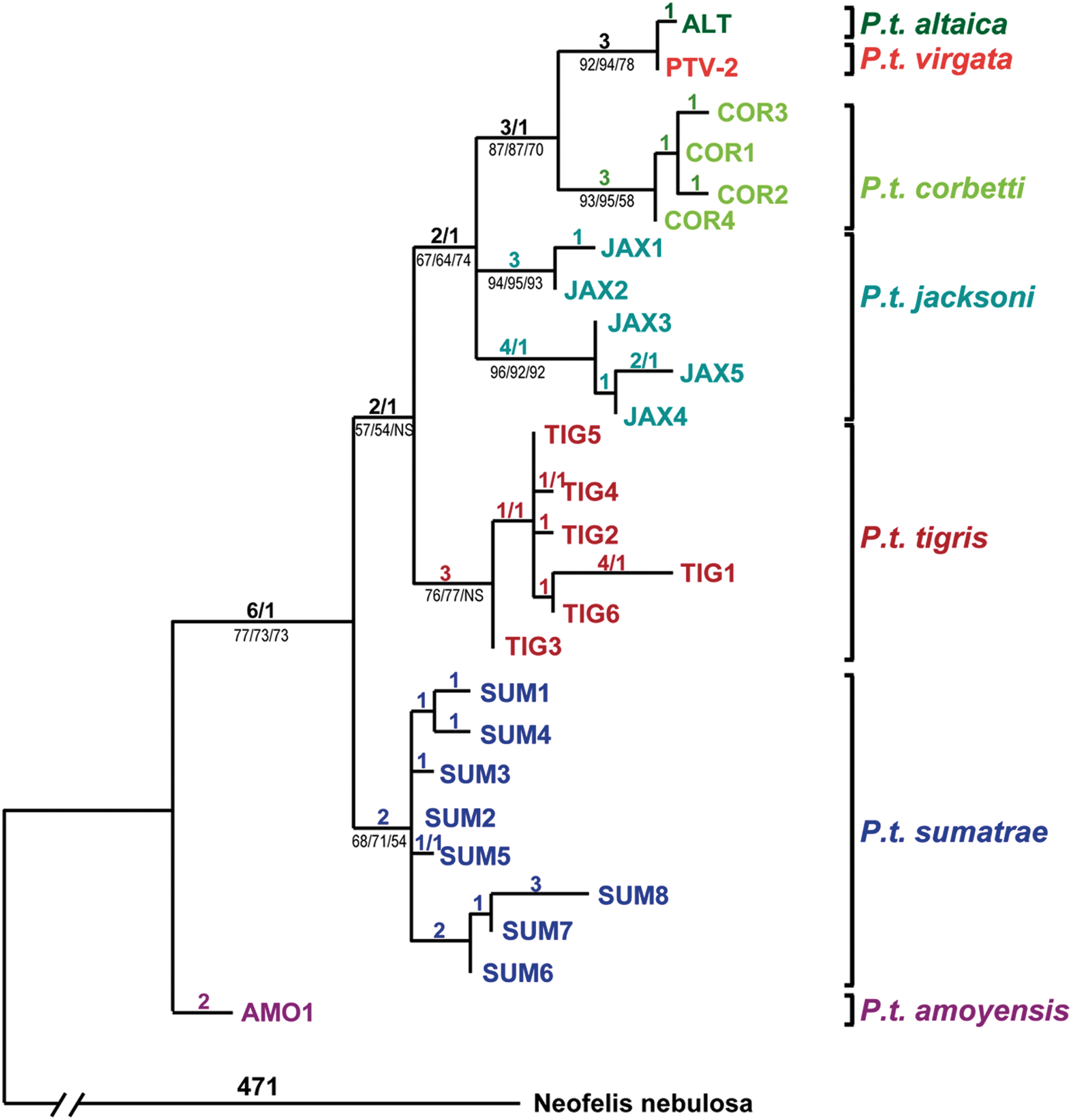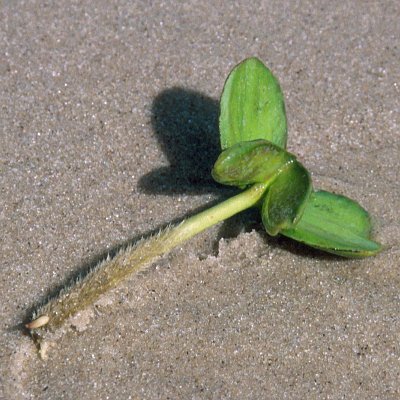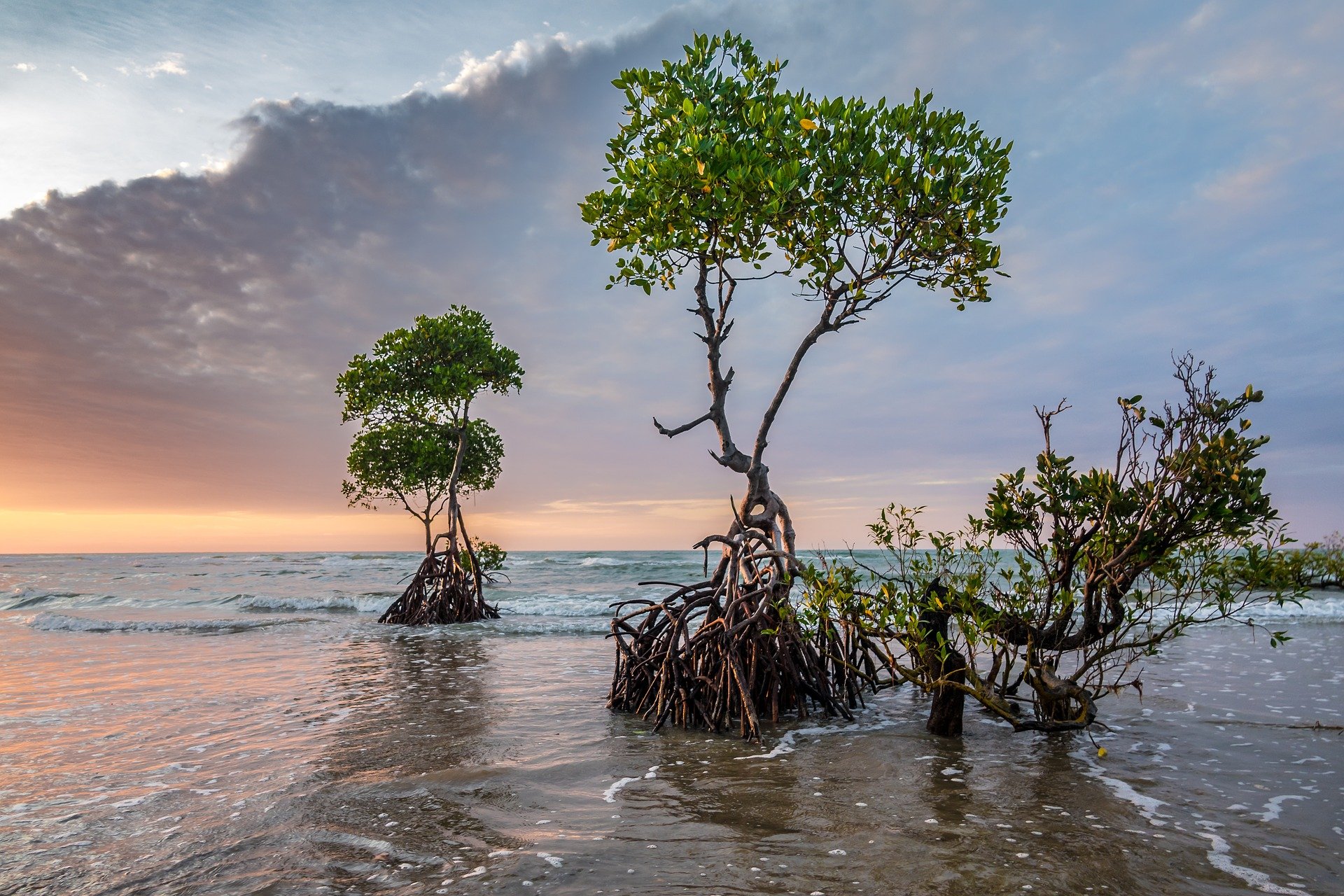|
Mangroves In India
Mangroves in India are coastal ecosystems characterized by salt-tolerant trees and shrubs, found predominantly along the eastern and western coastlines and in the Andaman and Nicobar Islands. India hosts some of the largest mangrove forests in the world, including the Sundarbans, Bhitarkanika, and the Krishna-Godavari delta regions. The total mangrove cover in India is 4,991.68 sq km, which accounts for 0.15% of the country's total area. Indian mangroves form 3% of the South Asia’s mangrove cover. Major Mangrove Forests in India India hosts several prominent mangrove forests, each with unique ecological characteristics: * Sundarbans (West Bengal): The Sundarbans is the largest mangrove forest in India and is part of the Ganges delta. It spans India and Bangladesh and is home to the endangered Royal Bengal tiger (Panthera tigris), saltwater crocodiles, and diverse bird species. The Sundarbans are a UNESCO World Heritage Site, recognized for their unique biodiversity and exte ... [...More Info...] [...Related Items...] OR: [Wikipedia] [Google] [Baidu] |
Sundarbans National Park
Sundarbans National Park is a national park in West Bengal, India, and core part of tiger reserve and Sundarbans Biosphere Reserve, biosphere reserve. It is part of the Sundarbans on the Ganges Delta and adjacent to the Sundarban Reserve Forest in Bangladesh. It is located to south-west of Bangladesh. The River delta, delta is densely covered by mangrove forests, and is one of the largest reserves for the Bengal tiger. It is also home to a variety of bird, reptile and invertebrate species, including the salt-water crocodile. The present Sundarban National Park was declared as the core area of Sundarban Tiger Reserve in 1973 and a wildlife sanctuary in 1977. On 4 May 1984 it was declared a national park. It is a UNESCO World Heritage Site inscribed in 1987, and it has been designated as a Ramsar site since 2019. It is considered as a World Network of Biosphere Reserve (Man and Biosphere Reserve) from 1989. The first forest management division to have jurisdiction over the Sundar ... [...More Info...] [...Related Items...] OR: [Wikipedia] [Google] [Baidu] |
Bengal Tiger
The Bengal tiger is a population of the ''Panthera tigris tigris'' subspecies and the nominate tiger subspecies. It ranks among the largest wild cats alive today. It is estimated to have been present in the Indian subcontinent since the Late Pleistocene for about 12,000 to 16,500 years. Its historical range covered the Indus River valley until the early 19th century, almost all of India, southern Nepal, Bangladesh, Bhutan and southwestern China. Today, it inhabits India, Bangladesh, Nepal, Bhutan, and southwestern China. It is threatened by poaching, habitat loss and habitat fragmentation. As of 2022, the Bengal tiger population was estimated at 3,167–3,682 individuals in India, 316–355 individuals in Nepal, 131 individuals in Bhutan and around 114 individuals in Bangladesh. Taxonomy ''Felis tigris'' was the scientific name used by Carl Linnaeus in 1758 for the tiger. It was subordinated to the genus ''Panthera'' by Reginald Innes Pocock in 1929. Bengal is the traditional ... [...More Info...] [...Related Items...] OR: [Wikipedia] [Google] [Baidu] |
Bhitarkanika Mangroves
Bhitarkanika Mangroves is a mangrove wetland in Odisha, India, covering an area of in the Brahmani River and Baitarani River deltas. History The Bhitarkanika Mangroves were zamindari forests until 1952, when the government of Odisha abolished the zamindari system, and put the zamindari forests in the control of the state forest department. In 1975, an area of was declared the Bhitarkanika Wildlife Sanctuary. The core area of the sanctuary, with an area of , was declared Bhitarkanika National Park in September 1998. The Gahirmatha Marine Wildlife Sanctuary, which bounds the Bhitarkanika Wildlife Sanctuary to the east, was created in September 1997, and encompasses Gahirmatha Beach and an adjacent portion of the Bay of Bengal. Bhitarkanika Mangroves were designated a Ramsar Wetland of International Importance in 2002. Flora and fauna About 62 mangrove species occur in the Bhitarkanika Mangroves, including ''Avicenna'', '' Bruguiera'', '' Heritiera'' and '' Rhizophora''. ... [...More Info...] [...Related Items...] OR: [Wikipedia] [Google] [Baidu] |
Pichavaram
Pichavaram is one of the villages of Parangipettai near Chidambaram in Cuddalore District, Tamil Nadu, India. It is located between the Vellar estuary in the north and Coleroon estuary in the south. The Vellar-Coleroon estuarine complex forms the Killai backwater and the mangroves that are permanently rooted in a few feet of water. It is located at a distance of 243 km from Chennai and 15 km from Chidambaram. Mangrove forests Pichavaram consists of a number of islands interspersing a vast expanse of water covered with mangrove forest. The Pichavaram mangrove Forest is one of the largest mangrove forests in India covering about 45 km2 of area (as of 2019). It is separated from the Bay of Bengal by a sand bar. The biotope consists of species like Avicennia and Rhizophora. It also supports the existence of rare varieties of economically important shells and fishes. Fauna The mangroves also attract migrant and local birds including snipes, cormorants, egre ... [...More Info...] [...Related Items...] OR: [Wikipedia] [Google] [Baidu] |
Godavari–Krishna Mangroves
The Godavari–Krishna mangroves are a mangrove ecoregion of India's eastern coast. Location and description The ecoregion covers an area of , in discontinuous enclaves extending from the state of Odisha in the north to Tamil Nadu in the south. The largest mangrove community in the ecoregion lies in the river delta, delta of the Godavari River, Godavari and Krishna River, Krishna rivers in Andhra Pradesh; other mangrove communities can be found at Point Calimere in Tamil Nadu, Pulicat Lake in Andhra Pradesh and Tamil Nadu, the Bhitarkanika Mangroves and Chilika Lake in Odisha, and the Pichavaram mangroves in Tamil Nadu. World Wildlife Fund. Flora The predominant mangroves are all of the species include ''Avicennia marina'', ''Suaeda'' spp., ''Rhizophor ...[...More Info...] [...Related Items...] OR: [Wikipedia] [Google] [Baidu] |
Sundarban Tiger
Sundarbans (; pronounced ) is a mangrove forest area in the Ganges Delta formed by the confluence of the Ganges, Brahmaputra and Meghna Rivers in the Bay of Bengal. It spans the area from the Hooghly River in India's state of West Bengal to the Baleswar River in Bangladesh's Khulna Division. It comprises closed and open mangrove forests, land used for agricultural purpose, mudflats and barren land, and is intersected by multiple tidal streams and channels. Spread across , it is the world's largest mangrove forest. The islands are also of great economic importance as a storm barrier, shore stabiliser, nutrient and sediment trap, a source of timber and natural resources, and support a wide variety of aquatic, benthic and terrestrial organisms. They are an excellent example of the ecological processes of monsoon rain flooding, delta formation, tidal influence and plant colonisation. Covering 133,010 ha, the area is estimated to comprise about 55% forest land and 45% wetlands in ... [...More Info...] [...Related Items...] OR: [Wikipedia] [Google] [Baidu] |
Rhizophora
''Rhizophora'' is a genus of tropical mangrove trees, sometimes collectively called true mangroves. The most notable species is the red mangrove ('' Rhizophora mangle'') but some other species and a few natural hybrids are known. ''Rhizophora'' species generally live in intertidal zones which are inundated daily by the ocean. They exhibit a number of adaptations to this environment, including pneumatophores that elevate the plants above the water and allow them to respire oxygen even while their lower roots are submerged and a cytological molecular "pump" mechanism that allows them to remove excess salts from their cells. The generic name is derived from the Greek words ῥίζα (''rhiza''), meaning "root," and φορός (''phoros''), meaning "bearing," referring to the stilt-roots. The beetle '' Poecilips fallax'' is a common pest of these trees, especially ''Rhizophora mucronata'' and '' Rhizophora apiculata''. This beetle (related to carver beetles) lays its eggs in the ... [...More Info...] [...Related Items...] OR: [Wikipedia] [Google] [Baidu] |
Avicennia
''Avicennia'' is a genus of flowering plants currently placed in the bear's breeches family, Acanthaceae. It contains mangrove trees, which occur in the intertidal zones of estuarine areas and are characterized by its "pencil roots", which are aerial roots. They are also commonly known as ''api api'', which in the Malay language means "fires", a reference to the fact that fireflies often congregate on these trees. Species of ''Avicennia'' occur worldwide south of the Tropic of Cancer. The taxonomic placement of ''Avicennia'' is contentious. In some classifications, it has been placed in the family Verbenaceae, but more recently has been placed by some botanists in the monogeneric family Avicenniaceae. Recent phylogenetic studies have suggested that ''Avicennia'' is derived from within Acanthaceae, and the genus is included in that family in the Angiosperm Phylogeny Group system. Designation of species is made difficult by the great variations in form of '' Avicennia mari ... [...More Info...] [...Related Items...] OR: [Wikipedia] [Google] [Baidu] |
Sonneratia
''Sonneratia'' is a genus of plants in the family Lythraceae. Formerly the Sonneratia were placed in a family called Sonneratiaceae which included both the ''Sonneratia'' and the '' Duabanga'', but these two are now placed in their own monotypic subfamilies of the family ''Lythraceae''. The genus was also named ''Blatti'' by James Edward Smith, but ''Sonneratia'' had botanical nomenclature priority. ''Sonneratia'' species are mangrove trees. Species The genus ''Sonneratia'' has the following species: *'' Sonneratia alba'' Sm. *'' Sonneratia apetala'' Banks *'' Sonneratia caseolaris'' (L.) Engl. *'' Sonneratia griffithii'' Kurz *'' Sonneratia × gulngai'' N.C.Duke *'' Sonneratia × hainanensis'' W.C.Ko, E.Y.Chen & W.Y.Chen *'' Sonneratia lanceolata'' Blume *'' Sonneratia ovata'' Backer *'' Sonneratia × urama'' N.C.Duke See also *Mangroves A mangrove is a shrub or tree that grows mainly in coastal saline or brackish water. Mangroves grow in an equatorial climate, t ... [...More Info...] [...Related Items...] OR: [Wikipedia] [Google] [Baidu] |
Climate Change
Present-day climate change includes both global warming—the ongoing increase in Global surface temperature, global average temperature—and its wider effects on Earth's climate system. Climate variability and change, Climate change in a broader sense also includes previous long-term changes to Earth's climate. The current rise in global temperatures is Scientific consensus on climate change, driven by human activities, especially fossil fuel burning since the Industrial Revolution. Fossil fuel use, Deforestation and climate change, deforestation, and some Greenhouse gas emissions from agriculture, agricultural and Environmental impact of concrete, industrial practices release greenhouse gases. These gases greenhouse effect, absorb some of the heat that the Earth Thermal radiation, radiates after it warms from sunlight, warming the lower atmosphere. Carbon dioxide, the primary gas driving global warming, Carbon dioxide in Earth's atmosphere, has increased in concentratio ... [...More Info...] [...Related Items...] OR: [Wikipedia] [Google] [Baidu] |
Mangrove Forest
Mangrove forests, also called mangrove swamps, mangrove thickets or mangals, are productive wetlands that occur in coastal intertidal zones. Mangrove forests grow mainly at tropical and subtropical latitudes because mangrove trees cannot withstand freezing temperatures. There are about 80 different species of mangroves, all of which grow in areas with low-oxygen soil, where slow-moving waters allow fine sediments to accumulate.What is a mangrove forest? National Ocean Service, NOAA. Updated: 25 March 2021. Retrieved: 4 October 2021. Many mangrove forests can be recognised by their dense tangle of prop roots that make the trees appear to be standing on stilts above the water. This tangle of roots allows the trees to handle the daily rise and fall of tides, as most mangroves get flooded at least twice per day. The roo ... [...More Info...] [...Related Items...] OR: [Wikipedia] [Google] [Baidu] |








